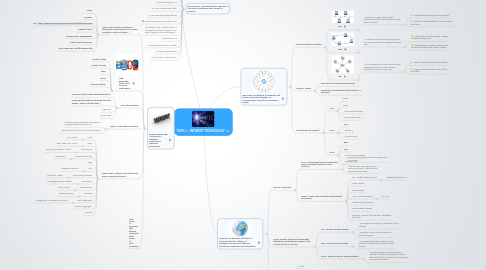
1. WORLD WIDE WEB (consists of a worlwide collection of electronic documents)
1.1. WEB PAGE (consists of electronic documents & can contain text, graphic, animation, audio and video.)
1.1.1. Static
1.1.2. Dynamic
1.1.3. eg. : http://www.nps.gov/grsm/planyourvisit/wildlifeviewing.htm
1.1.4. Protocol: http://
1.1.5. Domain name: www.nps.gov
1.1.6. Path: grsm/planyouvisit
1.1.7. Web page name: wildlifeviewing.htm
1.2. WEB BROWSER (allow users to access Web pages.)
1.2.1. Mozilla Firefox
1.2.2. Google Chrome
1.2.3. Safari
1.2.4. Opera
1.2.5. Internet Explorer
1.3. Ways of Navigating
1.3.1. Hypertext (links in text-based documents)
1.3.2. Hypermedia (combine text-based link with graphic, audio and video links.)
1.3.3. Hypertext
1.3.4. Hypermedia
1.4. Ways of Information searching
1.4.1. Subject Directory (classifies Web pages in an organized set of categories.)
1.4.2. Search Engine (finds info. to a specific topic)
1.5. WEB SITES (a collection of related Web pages & associated items.)
1.5.1. Portal
1.5.1.1. MSN, Yahoo
1.5.2. News
1.5.2.1. BBC News, NST Online
1.5.3. Informational
1.5.3.1. RMP (royal Malaysian Police)
1.5.4. Business/Marketing
1.5.4.1. Tupperware
1.5.5. Blog
1.5.6. Wiki
1.5.6.1. Wikipedia, Foodista
1.5.7. Online Social Network
1.5.7.1. Facebook, Twitter
1.5.8. Educational
1.5.8.1. Just English Explorer website
1.5.9. Entertainment
1.5.9.1. Yahoo Launch
1.5.10. Advocacy
1.5.10.1. Greenpeace.com
1.5.11. Web Application
1.5.11.1. Google Doc., Windows Live Hotmail
1.5.12. Content Aggregator
1.5.13. Personal
1.6. Web server (a computer that delivers requested Web pages to your computer)
2. NETIQUETTE - Netwok/Internet etiquette is the term of politeness when using the Internet.
2.1. Three areas where good netiquette is highly stressed : i) e-mail ii) newsgroup iii) online chat
2.2. Rules of Netiquette
2.3. 1) Keep message brief.
2.4. 2) Be clear.
2.5. 3) Use appropriate language.
2.6. 4) Be careful when using sarcasm & humor.
2.7. 5) Avoid sending SPAM.
2.8. 6) Avoid forward chain letter.
2.9. 7) Avoid sending/posting flames.
2.10. 8) Never read someone's private e-mail.
2.11. 9) Clearly identify a spoiler which is a message that reveals a solution to a game/ending to a movie/program.
2.12. 10) Read the FAQ
2.13. 11) Be forgiving of other's mistake.
2.14. 12) Obey copyright laws.
2.15. 13) Cite other's work you use.
3. INTERNET (a worlwide collection of networks that links millions of businesses, government agencies, educational institutions and individuals.)
3.1. Internet Connection
3.1.1. DIAL-UP (low speed Internet connection using a standard telephone line to connect.)
3.1.1.1. Conventional (PC has to dial via a phone line to connect.)
3.1.1.2. INTEGRATED SERVICES DIGITAL NETWORK (ISDN) : (transfer data using two phone lines.)
3.1.2. DIRECT / BROADBAND (high-speed Internet connection)
3.1.2.1. DSL - Digital Subscriber Line
3.1.2.1.1. Streamyx without Wi-Fi
3.1.2.2. Cable modem
3.1.2.3. Fixed wireless
3.1.2.4. Wi-Fi : Wireless Fidelity
3.1.2.4.1. P1, YES
3.1.2.5. Satelite Internet Services
3.1.2.6. Cellular Radio Network
3.1.2.7. FttP/BoF - Fiber to the Premises / Broadband over Fiber
3.2. Access Provider (business that provides individuals & organizations access to the Internet for free or for fee.)
3.2.1. ISP - Internet Service Provider
3.2.1.1. - providing & maintaining a connection to the Internet.
3.2.1.2. - provide 24-hour customer service & technical support.
3.2.2. OSP - Online Service Provider
3.2.2.1. - company that provides Internet access (services) as well as many members-only features.
3.2.3. WISP - Wireless Internet Service Provider
3.2.3.1. - provides wireless Internet access to desktop & noebook computers & mobile devices with built-in capacity or to computer using wireless modem.
3.3. Internet Services
3.3.1. e-mail
3.3.2. Mailing List
3.3.3. Instant Messaging (IM)
3.3.4. Chat
3.3.5. VoIP - Voice over Internet Protocol
3.3.6. Newsgroup
3.3.7. FTP - File Transfer Protocol
3.3.7.1. FileZilla
3.3.8. Telnet
4. NETWORK (a collection of computer and devices connected together via communication network & transmission media)
4.1. Types of Network Topology
4.1.1. Bus
4.1.1.1. - consists of a single central cable (backbone) to which all computers & other devices connect.
4.1.1.1.1. - inexpensive compared to other neworks
4.1.1.1.2. - difficult to identify problem if entire network shut down.
4.1.2. RIng
4.1.2.1. - a cable forms a closed loop (ring) will all computers and devices arranged along the ring.
4.1.2.1.1. - cable faults are easily located, making troubleshooting easier.
4.1.2.1.2. - data packets must pass through every computer therefore, this makes it slower.
4.1.3. Star
4.1.3.1. - all the computers & other devices on the network connect to a central device (hub/switch), thus forming a star.
4.1.3.1.1. - easy to troubleshoot & isolate problem.
4.1.3.1.2. - expensive because of the costs of the hub/switch.
4.2. Network Layout
4.2.1. Physical layout (cabling arrangement)
4.2.2. Logical layout (path where data travels on a Network)
4.3. Classification of Network
4.3.1. LAN
4.3.1.1. PAN
4.3.1.2. HAN
4.3.1.3. - easy to share devices.
4.3.1.4. - easy to share data.
4.3.2. MAN
4.3.2.1. CAN
4.3.2.2. - efficiency
4.3.2.3. - shared access
4.3.3. WAN
4.3.3.1. EPN
4.3.3.2. VPN
4.3.3.3. - ease of communication.
4.3.3.4. - lowered costs.
